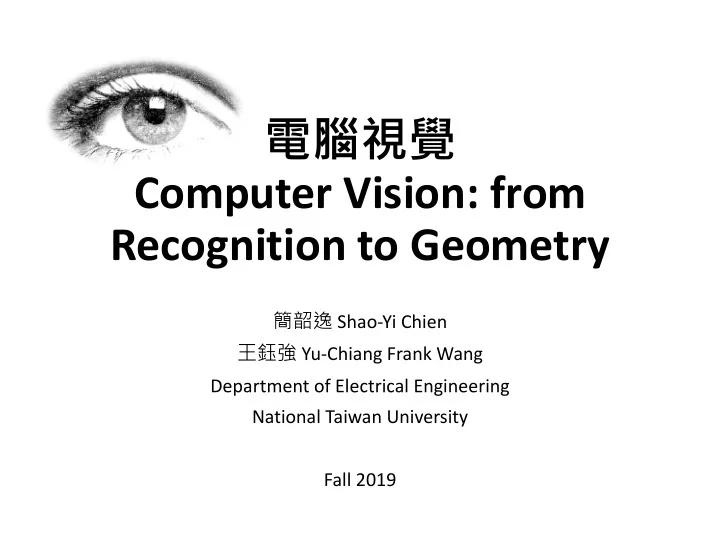

���� Computer Vision: from Recognition to Geometry ��� Shao-Yi Chien ��� Yu-Chiang Frank Wang Department of Electrical Engineering National Taiwan University Fall 2019
Computer Vision • Describe the world that the computer see in one or more images and to reconstruct its properties, such as shape, illumination, and color distribution • Is it hard? An inverse problem
Computer Vision [R. C. James]
Computer Vision
Wide Applications of Computer Vision • Optical character recognition (OCR) Digit recognition, AT&T labs License plate readers http://www.research.att.com/~yann/ http://en.wikipedia.org/wiki/Automatic_number_plate_recognition
Wide Applications of Computer Vision • Face detection: in all digital cameras and smart phones
Wide Applications of Computer Vision • Face detection: in all digital cameras and smart phones [Sony]
Wide Applications of Computer Vision • Iris recognition (Vision-based biometrics) “ How the Afghan Girl was Identified by Her Iris Patterns ” Read the story
Wide Applications of Computer Vision • Object recognition [Girod et al. 2011] [slyce.it]
Wide Applications of Computer Vision • Shape capture The Matrix movies, ESC Entertainment, XYZRGB, NRC
Wide Applications of Computer Vision • Motion capture Pirates of the Carribean , Industrial Light and Magic
Wide Applications of Computer Vision • Computer vision in sports Intel: freeD technology Hawk-Eye: helping/improving referee decisions
Wide Applications of Computer Vision • Smart cars: ADAS [Intel Mobileye]
Wide Applications of Computer Vision • Surveillance system Ref: Chih-Wei Wu, Meng-Ting Zhong, Yu Tsao, Shao-Wen Yang, Yen-Kuang Chen, and Shao-Yi Chien, "Track-clustering Error Evaluation for Track-based Multi-camera Tracking System Employing Human Re-identification," CVPR 2016 Workshop .
Wide Applications of Computer Vision • Vision-based interaction [Microsoft Xbox]
Wide Applications of Computer Vision
Wide Applications of Computer Vision • Robotics NASA’s Mars Spirit Rover http://www.robocup.org/ http://en.wikipedia.org/wiki/Spirit_rover
Wide Applications of Computer Vision • Medical image Image guided surgery 3D imaging Grimson et al., MIT MRI, CT
Important Near-Future Applications • AR/VR • Autonomous vehicle • Robot • IoT: AIoT (AI+IoT), IoVT (Internet-of-Video-Things) • Medical imaging • Large-scale video analysis • Computational photography/image synthesis • Industrial automation • …
Related Fields Digital Image Processing Computer Geometry (3D) (Computational photography) Vision Shape Images (2D) Photometry Computer Appearance Graphics • The boundaries between digital image processing/computer vision/computer graphics become vague nowadays
About this Course… • Provide a comprehensive introduction to the field of computer vision (CV) • From classical methods to deep learning based methods • From recognition to geometry • No experiences in CV and image process are required • The two courses, Computer Vision and Deep Learning for Computer Vision, can give you a complete view of modern CV techniques • Grading • Four homeworks: 60% • Class/talk participation: 10% • Group final project: 30%
Course Website • Course website • http://media.ee.ntu.edu.tw/courses/cv/19F/ • TA • ��� • MD-431 • jackieliu@media.ee.ntu.edu.tw • Will lead TA teams for each homework
(Tentative) Schedule: May be Modified… Week Date Topic 1 9/11 Introduction to human vision systems 2 9/18 Camera basic, image formation and basic Image processing 3 9/25 Segmentation 4 10/2 Machine learning basics 5 10/9 Deep learning basics 6 10/16 Recognition 7 10/23 Feature detection and matching 8 10/30 Projective Geometry 9 11/6 Estimation of Transformations 10 11/13 Single Camera Geometry/Camera calibration 11 11/20 Two-View Geometry 12 11/27 Dense motion estimation/stereo 13 12/4 Structure from motion 14 12/11 3D reconstruction/depth sensing 15 12/18 Optical flow + object tracking 16 12/25 Advanced topics in CV 17 1/1 �� 18 1/8 CES 19 1/17 Final Project
Homeworks • Four assignments: • HW1: Image filters • HW2: Detection or recognition • HW3: Pose estimation • HW4: Stereo matching • Official language is Python • Lab0: Python and basic image processing • 9/19 18:30--20:00 @ EEII-143
Final Project • Will have one or two problems/challenges • Each team should have 3—4 members • Project may be supported by industry with awards • Evaluated by professor, TAs, guest judges from industry, and you (peer review)! • The problems/challenges will be announced around the week of mid exam
Reference Materials • Reference books http://szeliski.org/Book/ • And papers in CVPR, ICCV, ECCV, BMVC, WACV, ACCV, ….
Recommend
More recommend